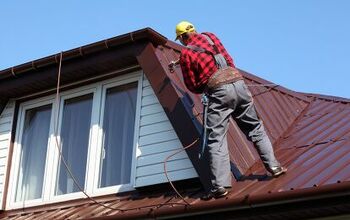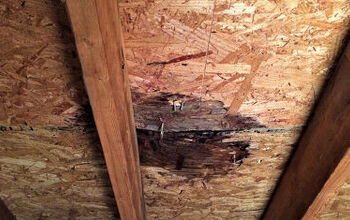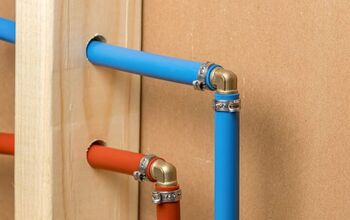How To Find A Roof Leak With No Attic (Do This!)

A leaky roof can be very problematic. Failing to do something about the leak ahead of time makes your home vulnerable to passing thunderstorms. Your ceiling and other parts of your home may end up badly damaged due to a previously small leak opening up.
Fixing the leak in your roof as soon as possible is a must. Before you can fix that leak though, you first have to find it. If you don’t have an attic, pinpointing the leak will be a bit trickier, but it can still be done.
With no attic to use, your best bet is to go up to your roof and look for signs of damage. Use a roofing ladder and some accessories to make climbing up as safe as possible. Once you’re up there, look for signs of damage or use a hose to soak the roof and pinpoint the leaks.
Even a small leak in your roof can turn into a big problem very quickly. Find the leak right away by following the tips included in this article.
Do You Need Roofing Repair Services?
Get free, zero-commitment quotes from pro contractors near you.

How To Find A Leak In Your Roof Without An Attic
Spotting a leak along your roof is easy if you have an attic. You can head up there, take a closer look at the ceiling, and spot problems early on.
Obviously, not all homes have attics. Don’t worry though because you can still find the leaks even without attic access and without calling for professional help. Follow the steps below if you want to find the leaks yourself.
Step 1: Secure A Roofing Ladder
With no access to an attic, the next best thing you can do is to head up to your roof. To do that, you’ll need a roofing ladder.
Roofing ladders come with accessories that make them easier to secure on to the side of a structure. Hooks are often provided for the purposes of locking the ladder into place. They even have wheels that make them easier to extend vertically.
Remember to check on the live load rating of the ladder and see if it can support your weight. You should also double-check to see if the ladder is tall enough to reach your roof.
Also consider purchasing accessories such as mitts, mount guards, or stabilizer bars to secure the ladder. If you won’t be using a stabilizer bar, you’ll have to tie off the ladder to keep it in place.
Step 2: Search For Signs Of Damage
Now that you’re up on the roof, you can start searching for signs of damage. Look for dark stains or mold because they typically surround the leak. You should also check for holes or damaged shingles because they may be causing the leaks.
Step 3: Use A Hose To Pinpoint The Leak
Some leaks may be so small that it’s hard to see them with the naked eye. To find those leaks, you may have to simulate rain.
Ask a friend to stay in one of the rooms closest to your home’s roof. Now, run a garden hose up the ladder carefully. Now that you’re on the roof with the hose, ask another friend to turn the water on. Keep it to a low flow because you don’t need that much.
You can now start soaking specific spots along the roof with water. Soak each spot for about a minute or two then ask your friend in the room if water is dripping. If no water drips through, move to another spot and continue what you’re doing.
Eventually, water will fall through the roof and that’s where you need to check for the leak. You can mark that spot and continue with what you’re doing if you suspect that there are other leaks. After finding the leak, you can patch it up if the damage is minor. More serious damage will probably require the services of a roofer so just cover up that spot for now.
Whar Are The Causes Of A Leaking Roof?
Water can leak through your roof for a variety of reasons. Some of the most common explanations for that particular issue are detailed in this section.
Improper Installation Of Shingles Or Other Features
Unfortunately, even a recently finished roof can suffer from leaks. Improper installation of the shingles can compromise the roof. Badly damaged shingles will not be able to offer much in the way of protection.
Certain features such as chimneys and vents not being installed properly can also lead to the formation of leaks. Perhaps those features weren’t sealed properly. That could explain why so much rain is leaking through the roof.
Damage From Debris
Branches may fall from a tree growing close to your home and puncture your roof. Even if they don’t puncture the roof, tree branches can still cause damage. They can obstruct water flow and force the water to move through the roof.
A passing hailstorm can also deal serious damage to your roof. Be sure to check up on your roof in the aftermath of a hailstorm to see if it’s in good shape.
Roof Unable To Shed Water
Roofs are often sloped in one direction or another to allow for the faster draining of water. Even flat roofs are supposed to feature a little bit of a slope to counteract potential draining issues.
Your roofer may have forgotten about integrating that slope into the construction of your home. Because of that, the rainwater is now pooling instead of moving quickly away from the roof.
Wear And Tear
At some point, your roof will have to be replaced. Replacement may not be needed for a long time if good materials were used, but it will still be required eventually. The leaks will simply grow larger if you fail to do something about your old and worn down roof.
What Are The Signs Of A Leaky Roof?
Checking up on your roof from time to time is a good idea. Doing so allows you to detect leaks and address them before they cause bigger problems. Let’s be honest though, that kind of maintenance task is something many of us are prone to forgetting.
The leaks can still make their presence felt though and they can do so without dripping water on to your floor. The items mentioned in this section are telltale signs of a leaky roof. Always keep a close eye out for them and be ready to take action as soon as you notice them.
Various Spots And Stains
Water damage may show up in the form of spots and stains. They look like black or dark brown marks and they may show up on your ceiling or along your home’s walls. It’s easy to miss them at first, but they will grow in size if they are ignored.
Musty Odor
Do you feel like that the air quality in your bedroom has seemingly gotten worse? Do you sometimes detect a faint yet musty odor lingering in the air whenever you enter the room?
You shouldn’t dismiss that odd smell as nothing or as a figment of your imagination. The musty smell is likely a byproduct of a leak and a sign that you must act sooner rather than later.
Bulging Spots Along Your Ceiling And Walls
Leaks that go unaddressed for a long time may start to cause bulging along your home’s ceiling and walls. At that point, significant damage has already been done to your home. Hopefully, you are able to do something about the leak before bulges of water start to form.
Do You Need Roofing Repair Services?
Get free, zero-commitment quotes from pro contractors near you.

Related Questions
Will Insurance Cover the Damage to Your Roof?
Many home insurance policies do feature coverage for roof damage. However, they may only payout if the damage is caused by forces of nature such as strong winds or hail. Read over your policy to see if your insurance will cover the repairs you need.
How Long Will It Take to Get a Leak in Your Roof Professionally Repaired?
Professional roofers can address leaks pretty quickly. Most leaks can be addressed in about an hour or so assuming that your roof has not been damaged that badly. Go ahead and call for a roofer even on a weekday if you want that leak patched up immediately.

Gary Evans is passionate about home improvement. He loves finding out how to make improvements in the easiest, most practical, and most affordable ways. Upgrading his home kitchen is one of his ongoing hobbies. Gary is also a long-time content creator and enjoys spending his free time tending to his hydroponic vegetable garden.
More by Gary Evans
















![12 Washing Machine Brands to Avoid [with Recall Data]](https://cdn-fastly.upgradedhome.com/media/2023/07/31/9075781/12-washing-machine-brands-to-avoid-with-recall-data.jpg?size=350x220)










